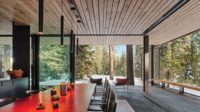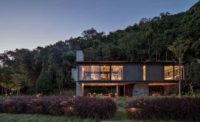After more than six decades, even homes designed during the peak of Modernism are starting to look dated. Seattle-based Olson Kundig recently revived a classic example from 1951, perched high up in the hills of Berkeley, California. “It was a solid midcentury house, with a strong parti,” says principal Tom Kundig. “Our challenge was to maintain the spirit of the building.”
Additional Information:Jump to credits & specifications
The original architect, John Ekin Dinwiddie, is one of the now-forgotten practitioners in the Bay Area who were pushing the envelope. The house he designed for his sister-in-law caused consternation among the neighbors on this closely packed hillside, overlooking the East Bay and San Francisco. Dinwiddie organized the building around the view, designing the living room as a long, fully glazed bar with the panorama of the Bay in front and a quiet courtyard in back. On the south end of the bar, he placed a wing with the dining area, kitchen, and maid’s quarters; he bracketed the north end with a two-story volume with bedrooms on both levels and clad two impressive walls in Southwestern stacked-stone veneer that is very evocative of the era. But the house’s most startling element is an 8-foot-wide circular metal canopy, inset with a thick glass disc, that shades the front door. (It’s worth mentioning that Dinwiddie studied architecture with Eliel Saarinen at the University of Michigan in the 1920s and briefly partnered with Erich Mendelsohn while the German émigré taught at the University of California, Berkeley.)
When the new owners, a couple with a young child, purchased the house in 2010, it was largely in its original condition, save for a subpar kitchen renovation from the 1980s. Over the years, it had fallen into considerable disrepair—the sliding door in the living room had been caulked shut. “The clients liked the building, but wanted us to stabilize it and take the underlying thought a step further,” says Kundig. “That midcentury idea of open ing up to the garden is still a tenet today. But now we’re more transparent between those parts and pieces.”
The house, which has a concrete-slab and spread-footing foundation with wood and steel framing, was gutted and rebuilt. The design team augmented the two wings, increasing the building’s 4,000 square feet to 4,300 square feet; substantially reconfigured the bedrooms and bathrooms; and removed the wall between the kitchen and dining room to create one continuous family gathering place. For energy efficiency, the architects switched out the single-paned glazing for aluminum-framed double-paned windows and immense sliding doors, carefully matching the glazing units’ dimensions to the grid established by the existing structural columns.
The defining architectural features—the transparent living room, stacked-stone walls, geometric sun shades, and round canopy—are all as they had been. The architects also restored the ground level’s concrete flooring, removing the ceramic field tile that had been installed in the intervening years.
But there are also a few light touches that particularly show the hand of the most recent architect. The two-story volume features two narrow recessed windows, set at an angle, that provide light but also privacy from neighbors to the north. The newly enlarged front door (now 5 feet wide and 9 feet tall) is outfitted with an industrial-chic lockset from Kundig’s own hardware line. And the original pale-pink stucco and redwood siding is now all vertical cedar siding, stained black. “I wanted to articulate the diagram of the house—the solid ends with the transparent interior—more emphatically,” says Kundig. “I’m engaging this person who is no longer with us, in the language that has been passed down through generations, trying to understand what he was saying about how to live."
PeopleArchitect: Olson Kundig 159 South Jackson Street Suite 600, Seattle, WA 98104 Personnel in architect's firm who should receive special credit: Partner in charge: Tom Kundig, FAIA Project manager: Christopher Gerrick, AIA, LEED AP BD+C Staff architect: Yuki-Seda Kane, LEED AP BD+C (registered architect) General contractor: Alward Construction, 1035 Carleton Street, Berkeley, CA 94710
|
ProductsStructural System Wood and steel frame Exterior Cladding Masonry: Noel Moreno Masonry Metal panels: TJ Marone with Elipse Design Group Metal/glass curtain wall: Pacific Sash & Design Wood: T&G cedar siding with stain finish; Western Red Cedar - Select Tight Knot; B M Arborcoat Finish Moisture barrier: Stego Wrap Vapor Barrier Under Slab Other cladding unique to this project: Dave Pedierem - Diamond D. Concrete; Richard Southard - Bay Area Concrete Engravers Roofing Built-up roofing: APP Modified Bitumen; Johns Manville; Westco Roofing Tile/shingles: Rafael Anaya - Anaya Tile Other: Windows Metal frame: Fleetwood Windows & Doors; Pacific Sash & Design Glazing Skylights: VELUX Doors Metal doors: Fleetwood Windows & Doors, local vendor: Summit Doors & Windows Sliding doors: Fleetwood Windows & Doors, local vendor: Summit Doors & Windows Fire-control doors, security grilles: Special doors: Upswinging doors, other: Hardware Kitchen cabinet pulls: Olson Kundig | Tom Kundig Collection (Fabricated by 12th Avenue Iron) Security devices: Karl Dobrinch - Security Etc. Barn door hardware: Richard-Wilcox Hardware Interior Finishes Cabinetwork and custom woodwork: Gabriel Forsythe, Santa Cruz CA, gabrielforsythe.com Paints and stains: Benjamin Moore - Arborcoat Exterior Stain Wall coverings: Oiled Steel - TJ Marone with Eclipse Metal Fabrication Floor and wall tile: Porcelanosa; Heath Ceramics in Kitchen; Ceramic Tile Design (Vendor) in Master Bath (San Rafael CA, ceramictiledesign.net) Raised flooring: Engineered White Oak T&G in Modified Wax-Oil Finish Special interior finishes unique to this project: Furnishings and Special Features Bookcases: Dennis Luedeman, Oakland CA Staircase: Eclipse Metal Fabrication Plumbing Toto Duravit KWC Hansgrohe Kallista Dornbracht Vola Franz Viegener Alape Blu Bathworks Energy Photovoltaic system:Radiant Heat System - Designed by Monterey Energy Group, Installed by Eran Getraide - Radiant Heat Systems, Inc. |









Post a comment to this article
Report Abusive Comment